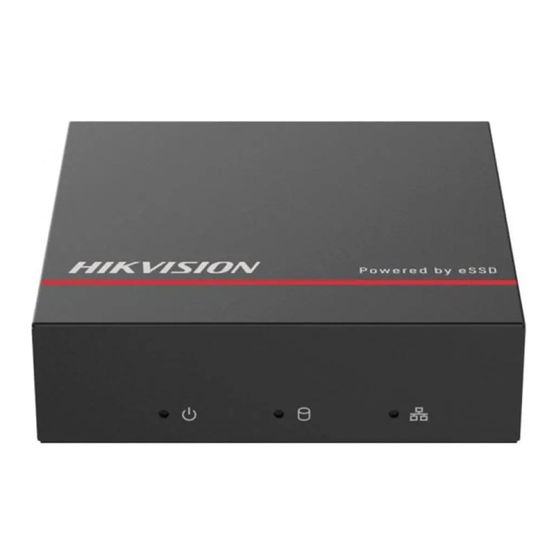
Table of Contents
Advertisement
Advertisement
Table of Contents

Summarization of Contents
Legal Information
About this Manual
Provides instructions for using and managing the product, including information on usage and safety guidelines.
Trademarks
Lists Hikvision's trademarks and logos, and notes that other mentioned trademarks are properties of their respective owners.
Disclaimer
Outlines limitations of liability, warranties, and user responsibilities regarding product usage and internet security risks.
Regulatory Information
FCC Information
Details FCC compliance for Class A digital devices, including potential interference and measures to correct it.
FCC Conditions
States the two conditions under which the device must operate to comply with FCC rules.
EU Conformity Statement
Confirms product compliance with harmonized European standards under EMC, LVD, and RoHS directives.
Industry Canada ICES-003 Compliance
Confirms compliance with Industry Canada ICES-003 standards for digital devices.
Chapter 1 Startup
1.1 Activate Your Device
Guides through the initial device activation process, including setting an admin password and activating network cameras.
1.2 Login
Explains the login procedures, including setting an unlock pattern and logging in via password.
Chapter 2 Live View
2.1 GUI Introduction
Introduces the Graphical User Interface for live view, including shortcut menus and icon descriptions.
2.2 PTZ Control
Details how to control PTZ (Pan, Tilt, Zoom) cameras, including parameter configuration and preset/patrol settings.
Chapter 3 Playback
3.1 GUI Introduction
Explains the Playback interface, including timeline controls and playback options.
3.2 Normal Playback
Guides on how to play back normal recorded videos, including date selection and playback controls.
3.3 Event Playback
Describes how to play back videos based on detected events like motion detection or line crossing.
3.4 Back up Clip
Details the process of clipping video segments during playback and exporting them to a backup device.
Chapter 5 Configuration (Easy Mode)
5.1 System Configuration
Covers basic system settings like date, time, resolution, user management, and exception handling.
5.2 Network Configuration
Details network settings including general IP configuration, Hik-Connect, and email notification setup.
5.3 Camera Management
Explains how to manage network cameras, including adding them, configuring OSD, and setting up smart events.
5.4 Recording Management
Covers storage device setup, recording schedule configuration, and parameter settings for recordings.
Chapter 6 Configuration (Expert Mode)
6.1 System Configuration
Provides advanced system configuration options for basic settings, DST, and device properties.
6.2 Network Configuration
Details expert network settings such as TCP/IP, DDNS, NAT, NTP, log server, ports, and ISUP.
6.3 Camera Management
Covers advanced camera management, including display settings, privacy masks, and protocol configurations.
6.4 Event Configuration
Explains configuration for normal and smart events, including motion detection, line crossing, and intrusion detection.
6.5 Recording Management
Details advanced recording management, including schedule, parameter, storage, and advanced settings.
Chapter 7 Maintenance
7.1 Restore Default
Guides on restoring device settings to factory defaults, including simple restore, factory defaults, and restore to inactive.
7.2 Search Log
Explains how to search, view, and export log information related to device operations, alarms, and exceptions.
7.3 System Service
Covers system service configurations, including RTSP authentication and ISAPI settings.
7.4 Upgrade
Details the process of upgrading the device firmware, including local and online upgrade methods.
Chapter 8 Alarm
8.1 Set Event Hint
Describes how to set event hints in the alarm center for various event types.
8.2 View Alarm in Alarm Center
Explains how to view alarm details by accessing the alarm center for different event categories.
Chapter 9 Web Operation
9.1 Introduction
Introduces accessing the device via a web browser and lists supported browsers and resolutions.
9.2 Login
Details the process of logging into the device through a web browser, including plugin installation.
9.3 Live View
Shows the live view interface accessible via the web browser after successful login.
9.4 Playback
Describes the playback interface accessible via the web browser for reviewing recorded footage.
9.5 Configuration
Guides on entering the configuration interface via the web browser.
9.6 Log
Explains how to access and search system logs through the web interface.
Chapter 10 Appendix
10.1 Glossary
Provides definitions for technical terms used throughout the manual, such as Dual-Stream, DVR, HDD, DHCP, and HTTP.
10.2 Communication Matrix
References a communication matrix document, likely detailing device communication protocols and interfaces.
10.3 Device Command
References a document containing device command information, useful for advanced control and integration.
















Need help?
Do you have a question about the DS-E08NI-Q1 and is the answer not in the manual?
Questions and answers